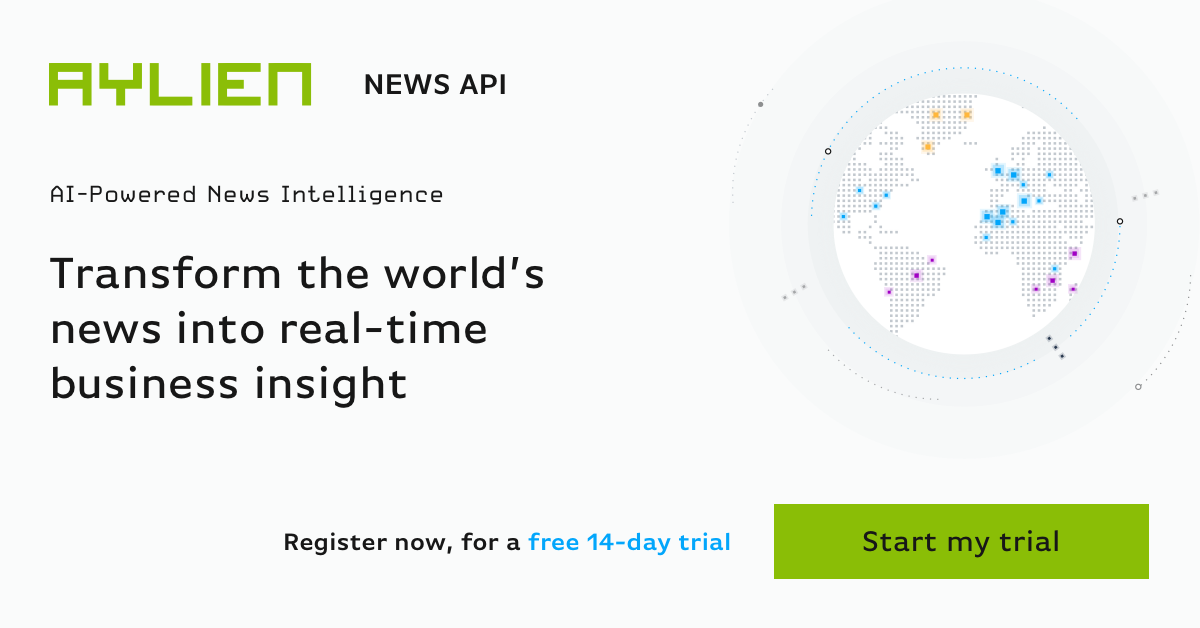Richard Pike joined the AYLIEN advisory board as a Financial Services Domain Expert. He currently holds and has held several board-level positions at some of the world's leading financial institutions such as Citadel, JP Morgan, ABN AMRO, FBD Insurance, and Starling International to name a few. He also lectures in Risk Management at the Institute of Banking and at the Smurfit Business School. In 2009 he was recognized as a “Top 50” Face of Operational Risk by Op Risk & Compliance magazine.
A key trend in risk management in recent years is that risk teams are increasingly using news data gathered from the internet to assist them in risk identification and monitoring. This article sets out some examples of this use of news and also highlights some challenges and approaches that risk managers can take to utilize this data effectively.
Why is news data increasingly important in risk management?
Many risks inherent within financial institutions’ business models are those that are driven by the outside world. They are either present in the transactional environment of customers, suppliers, and partners or in the contextual environment of regulators, politics, or social and environmental change. Monitoring the news closely for risk signals and sentiment should therefore be an essential part of every financial institution’s risk management framework.
Aside from these use cases where the only source of risk signals is outside the organization, news can also help with the risks that do have some internal data. Effective operational and compliance processes are often hindered by challenges that can be countered with a view to the outside world and emerging events. These challenges include:
- Poor access to relevant data
- Reliance on qualitative hunches
- Siloed focus when it comes to risk management
External news data can be used to add contextualized insight to internal assessments. Provided it is carefully organized and curated, news data can be an excellent source of objective data concerning customers, suppliers, regulatory actions, and other types of risk. That data can then be used to provide a more robust set of assessments that may be used to challenge qualitative assessments made by internal experts. Similarly structured and timely news data can show areas where risk boundaries are crossed and risks collide. This is very useful when attempting to counteract the Risk silos that can appear within financial firms and will show up areas where those internal silos must collaborate and share data.
News for Risk Identification
Horizon Scanning
This is the area where news has traditionally been used in risk management - scanning the environment for new risks due to changes in technology, the environment, and the political landscape. Brexit is a great example of a risk that didn’t exist 10 years ago and yet has caused huge changes and costs in the financial landscape for firms across the globe. The ability to survey the internet in a structured way to identify those new risks that may have a future effect on your firm is now seen as a vital part of any good risk management framework.
Rapidly evolving risks
Our recent experience of the pandemic is an example of how a risk that was known about (via the experience of SARS) rapidly evolved to have a much greater probability and impact than expected. This event has also shown senior managers that those low probability risks can indeed happen and on a much larger scale than expected. So risk managers are now developing ways to constantly monitor those low probability risks for change, as opposed to the annual or semi-annual review that was best practice a number of years ago.
Scenario generation
Scenarios are now the staple of most good risk management frameworks. They are used in Operational risk capital assessments and also increasingly in Operational resilience approaches. External news is being used to help generate those scenario ‘stories’ that are then brought within the firm to understand how, should they occur here, they would manifest. Again, due to the pandemic, senior managers and boards are challenging the risk teams to broaden their list of scenarios to ensure that lower probability risks are covered.
News for Risk Monitoring
Outsourcing risk
This is a hot topic at the moment with many regulators and boards. Firms are developing internal monitoring programmes to help understand the status of their outsource partners and ensure that they have excellent oversight of them. The more advanced firms are also adding external data to these assessments to ascertain if the third parties have other issues that they may not know about. So, these firms will get an internal monitoring score and pair that with an external monitoring score for each third party.
Scenario estimation
As mentioned above scenario generation often uses external news and we also see news used for scenario estimation, particularly in the estimation of probability. The latest event clustering techniques along with other analysis can generate really useful data to help estimate the probability of an event occurring, or at very least challenge internal assessments that may be overly optimistic or pessimistic.
Cyber risk
Given the rapidly changing nature of cyber risk, it is vital that risk teams use external news sources to monitor the internet for new and changing risks of this type. This is also the area in which the problem of too much data is most evident. So, the ability to organize and curate the news in this area to ensure that it is relevant and proportionate to your business is vital.
Regulatory risk
Regulators around the world are very busy these days generating new guidelines and rules and also communicating recent fines and enforcement actions. Compliance teams must stay abreast of their own regulator’s pronouncements and also watch what other regulators are saying that might influence others. The ability to filter and organize this data to ensure efficient follow-up is now vital to these compliance officers.
Challenges in news that can be overcome by banking on AI
Too much news - filtering, event detections and accurate search
There is a problem - the scale of global news in the 21st century is overwhelming, and the manual processes of traditional media monitoring are now inefficient, inaccurate, and ineffective. As a result, risk signals are either missed entirely or discovered too late. The solution is implementing an innovative technology, such as a News Intelligence Platform, that will significantly improve the process, providing NLP and ML capabilities to aggregate and understand global news in real time, so that risk signals do not go unnoticed.
Replacing manual processes with an automated system is a huge benefit to financial institutions. Instead of analysts sourcing and processing global news every day, a News Intelligence Platform automatically ingests hundreds of thousands of news articles from across the world as soon as they are published. Using NLP, it extracts key information from every article in real time, transforming unstructured data into structured, stored, and actionable data.
The result is the ability to flexibly, quickly, and accurately search for specific categories of news, as well as entities such as people, places, products, companies, and even concepts.
Many articles about the same story - deduplication and clustering
An important issue with news is that you often get multiple articles about the same story. This is both a benefit and a curse. The benefit is that you can cluster these articles and use that as a signal as to the importance of the story as it is clearly generating a lot of interest. On the curse side, it means that you may read countless articles that effectively say the same thing.
The latest News Intelligence Platforms can deduplicate these articles and also summarise the key ones, thus targeting the reader’s time and ensuring that the key facts are easily accessible.
Keeping an audit trail - central repository
As with everything in risk management, we need to keep an audit trail of our actions. This is very difficult to produce after a morning of surfing internet search tools to find news about a vendor or new cyber risk. News Intelligence Platforms can store a full audit of searches and filters along with who read what.
They can also have embedded workflows so that articles sent to colleagues or managers can be tracked and reported upon. The processes regarding external news set out in a risk management policy can be instantiated within the News Intelligence Platform and then reports can be produced to provide evidence that the policies were followed.
Innovation is vital to risk managers in enabling them to keep abreast of the rapidly changing risk landscape and Aylien has the tools and capabilities to offer significant products in this arena.

Richard Pike
Advisor, AYLIEN
Related Content
-
 General
General20 Aug, 2024
The advantage of monitoring long tail international sources for operational risk

Keith Doyle
4 Min Read
-
 General
General16 Feb, 2024
Why AI-powered news data is a crucial component for GRC platforms

Ross Hamer
4 Min Read
-
 General
General24 Oct, 2023
Introducing Quantexa News Intelligence

Ross Hamer
5 Min Read
Stay Informed
From time to time, we would like to contact you about our products and services via email.

